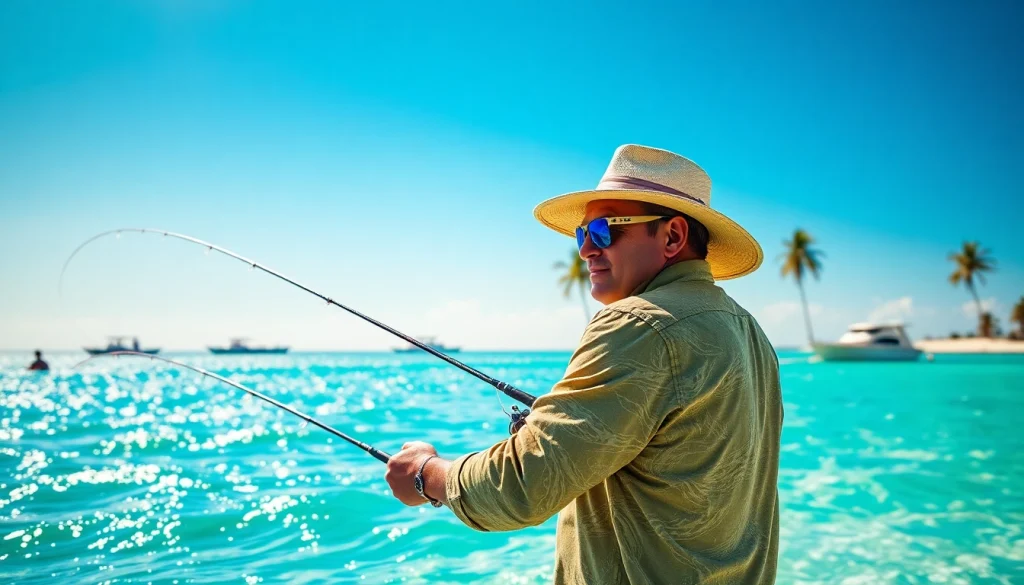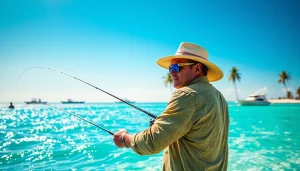Mastering Saltwater Fly Fishing: Techniques, Tips, and Best Destinations

Understanding Saltwater Fly Fishing
Saltwater fly fishing is a dynamic and exhilarating pursuit that challenges anglers in unique ways. Unlike freshwater fishing, saltwater fly fishing takes place in vast oceans, estuaries, and coastal bays, where fish are subject to the influences of tides, currents, and varying weather conditions. Anglers are often attracted to the thrill of targeting game fish like tarpon, bonefish, and permit in stunningly picturesque environments. If you’re keen to dive into this adventurous fishing sport, understanding its various dimensions is crucial. This article provides a comprehensive overview of saltwater fly fishing, including essential gear, techniques, top destinations, and insider tips from seasoned anglers.
What is Saltwater Fly Fishing?
Saltwater fly fishing involves using a fly rod, reel, and artificial flies crafted to mimic aquatic insects, crustaceans, or baitfish found in saltwater environments. Unlike traditional fishing methods that often rely on spinning or baitcasting gear, fly fishing requires a unique set of skills and knowledge. The essence of fly fishing lies in the ability to cast lightweight flies with precision and delicacy to entice fish to strike.
This fishing style draws enthusiasts for its engaging nature—casting becomes an art form rather than mere fishing. As anglers learn to read the water and gauge fish behavior, they develop a strong connection to the ecosystems they fish in.
The Unique Challenges of Saltwater Environments
Saltwater fishing poses distinct challenges not commonly found in freshwater fly fishing:
- Corrosive Environment: Saltwater can corrode exposed materials. Consequently, equipment must be designed with corrosion-resistant materials to ensure durability.
- Tidal Influence: Fish activity often correlates with tidal movements. Knowing when to fish during tides can significantly impact success.
- Stronger Fish: Saltwater species tend to be larger and more powerful, requiring robust gear and techniques to handle their strength effectively.
- Wind Conditions: Wind can complicate casting and line management, necessitating advanced casting skills to target fish effectively.
Essential Gear for Saltwater Fly Fishing
The right equipment is fundamental for success in saltwater fly fishing. Here are the essential components:
- Fly Rod: Choose a rod rated for saltwater use, typically heavier than freshwater rods. Ranges from 8 to 12 weights are ideal for larger game fish.
- Fly Reel: Opt for a corrosion-resistant reel with a robust drag system since saltwater species can exert immense pressure.
- Line: Use floating, sinking, or intermediate lines based on the targeted species and water depth.
- Leader Material: A high-quality leader is crucial. Use fluorocarbon leaders for better stealth, typically in the range of 15-25 pounds for saltwater fishing.
- Flies: Choose flies that mimic the local baitfish. Popular patterns include Clouser Minnows, Deceivers, and Crab patterns.
Techniques for Successful Saltwater Fly Fishing
Effective Casting Techniques for Saltwater
In saltwater fly fishing, effective casting can make or break your day. Successful anglers master the following techniques:
- Double Haul: Enhances casting distance by using two hand motions—one to pull the line and another to load the rod tip.
- Single Haul: A useful technique for improving line speed, especially under windy conditions.
- Roll Cast: An essential cast for tight situations where backcasting is impossible, allowing for a quick presentation.
Continuous practice and feedback from experienced anglers can rapidly improve your casting technique, helping you cast further and with more precision.
Reading Tides and Weather Patterns
Tides and weather greatly influence fish behavior and feeding patterns in saltwater environments. Here’s how to read these conditions:
- Tide Changes: Fish typically feed more aggressively around changing tides. High tides may bring fish closer to shore, while low tides push them farther out.
- Wind Direction: Wind can drive baitfish toward the shore and impact the movement of predator fish, making it a critical factor in planning your outing.
- Weather Fronts: Past heavy pressure systems can trigger feeding frenzies, so fishing right before or after a front can yield excellent results.
Choosing the Right Flies for Saltwater Species
The selection of flies often determines your success rate in saltwater fishing. Factors such as species targeted, time of year, and local conditions should guide your choices. Some proven patterns include:
- Clouser Minnow: Highly versatile, effective for species like striped bass and bonefish due to its baitfish resemblance.
- Bonefish Fly: Patterns like Crazy Charlie and Gotcha are popular for targeting bonefish in shallow flats.
- Crab Patterns: Essential for permit fishing, mimicking the natural prey of these species.
Experimenting with various colors and sizes can lead to discovering what works best for your specific fishing waters and conditions.
Key Destinations for Saltwater Fly Fishing
Top Tropical Locations
Tropical destinations are among the best places for saltwater fly fishing, offering stunning scenery and abundant fish species. Some top locations include:
- Key West, Florida: Famous for its bonefish, tarpon, and permit.
- Bahamas: With numerous flats and abundant marine life, the Bahamas is a favorite for fly fishers.
- Mexico’s Yucatan Peninsula: Known for world-class bonefish and permit fishing.
Hidden Gems for Enthusiasts
For those looking to escape the crowds, consider these hidden gems:
- Ascension Bay, Mexico: Offers pristine flats teeming with fish away from the masses.
- Florida’s Ten Thousand Islands: A maze of mangroves and bays that provide excellent fishing opportunities.
- Ascension Island, South Atlantic: Known for giant trevally, offering a remote but exciting fishing experience.
Seasonal Considerations for Each Destination
Understanding the best seasons for fishing is vital for maximizing your chances. Here are some general guidelines:
- Key West: Best from March to June for tarpon and bonefish.
- Bahamas: Optimal conditions from December to May, avoiding hurricane season.
- Yucatan Peninsula: Prime season is from April to September, with the best chances for bonefish and permit.
Tips and Tricks from Experienced Fly Fishers
Common Mistakes to Avoid
Even seasoned fly fishers can make mistakes. Avoid these common pitfalls:
- Not Matching the Hatch: Using flies that do not resemble the local bait can hinder success.
- Overcasting: Casting too far can reduce accuracy; focus on smooth, controlled casts.
- Ignoring Conditions: Failing to read tides and weather can lead to missed opportunities.
Maximizing Your Time on the Water
Time management on the water is crucial; here are some tips to ensure you make the most of your outings:
- Prepare Your Gear: Ensure all your gear is ready before heading out, including pre-tied leaders and organized flies.
- Work the Flats: Move slowly and carefully in the shallows to avoid spooking fish.
- Keep Notes: Document successful techniques, tides, and weather conditions to refine your approach over time.
Tackle Maintenance for Longevity
Maintaining your gear ensures longevity and performance. Here are some essential maintenance tips:
- Rinse with Freshwater: After each trip, rinse your gear to remove salt and avoid corrosion.
- Inspect Regularly: Check your line, rod, and reel for any signs of wear or damage.
- Store Properly: Store your flies in a dry, cool place to preserve their integrity and effectiveness.
Resources for Further Learning and Community Engagement
Recommended Books and Websites
Enhancing your fly fishing knowledge and skills is vital. Some valuable resources include:
- Books: “The Orvis Guide to Saltwater Fly Fishing” by Tom Rosenbauer is an excellent choice for both beginners and seasoned anglers.
- Websites: Websites like Salt Water Sportsman provide a wealth of articles, tips, and updates on saltwater fly fishing.
Joining Saltwater Fly Fishing Clubs
Participating in local fly fishing clubs can provide numerous benefits:
- Networking: Meet experienced anglers to share tips and organize fishing trips.
- Workshops: Many clubs host workshops to help improve your skills and knowledge.
- Access to Exclusive Locations: Some clubs have opportunities for members to fish in prime, otherwise restricted areas.
Participating in Fishing Tournaments
Competing in fishing tournaments can be a fun and rewarding way to meet other anglers while honing your skills:
- Increased Motivation: Tournaments provide competitive motivation to improve your fishing techniques.
- Prizes and Recognition: Many tournaments offer prizes, providing incentives for better performance.
- Community Building: Tournaments encourage community among local anglers, fostering relationships and shared experiences.





